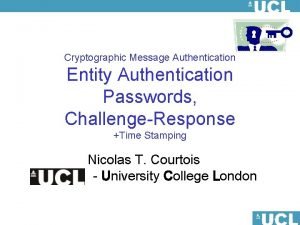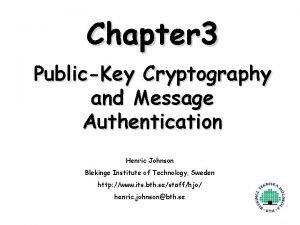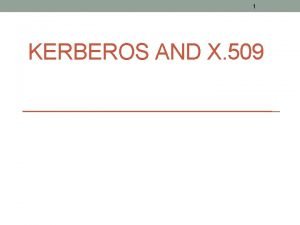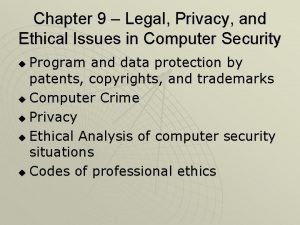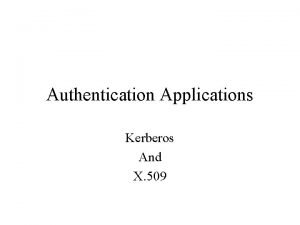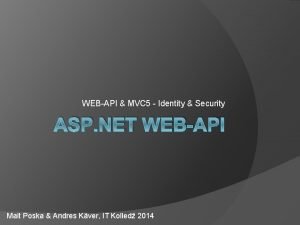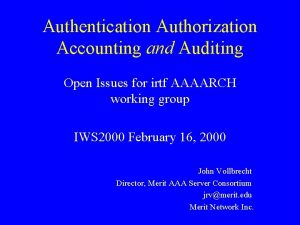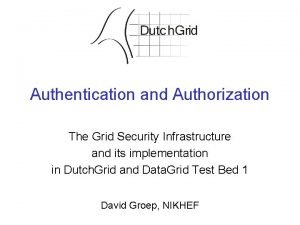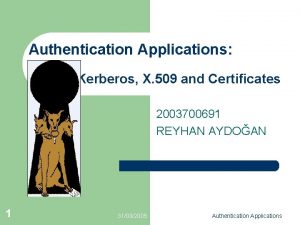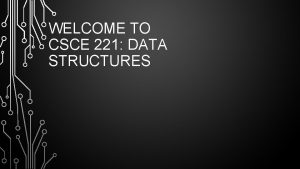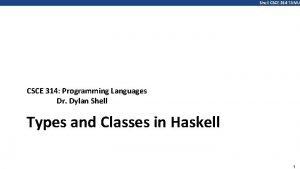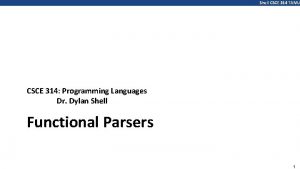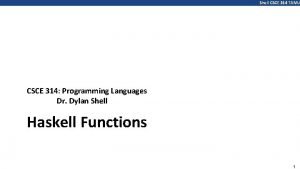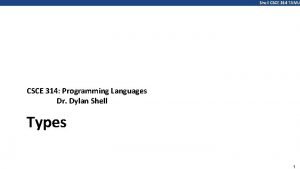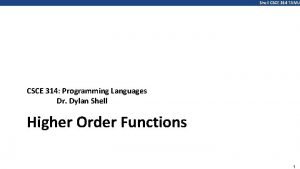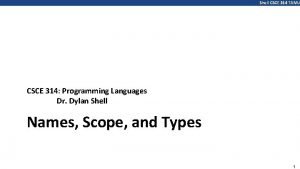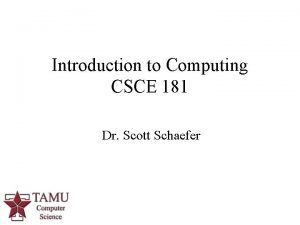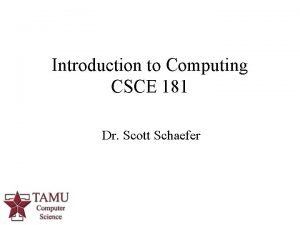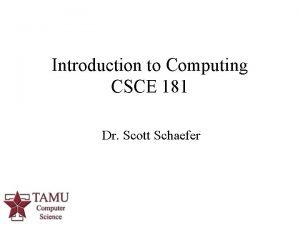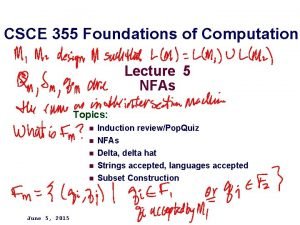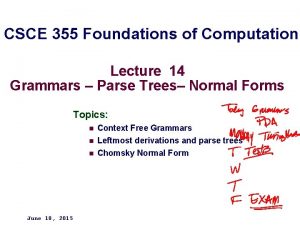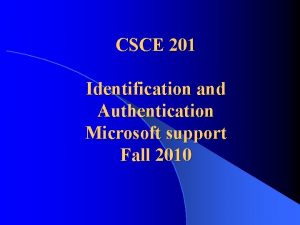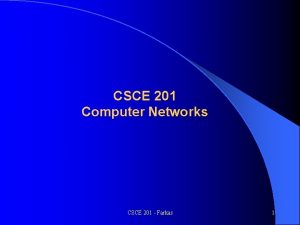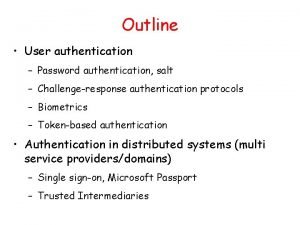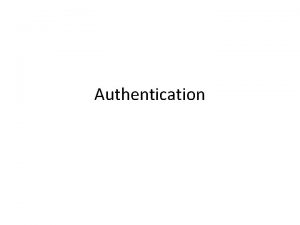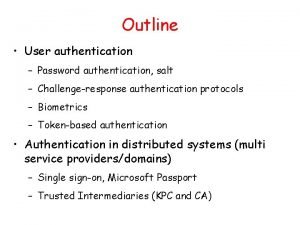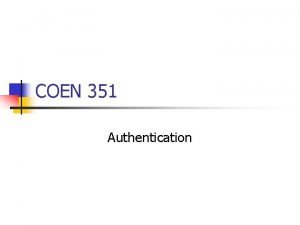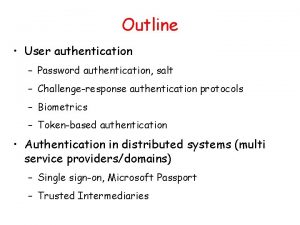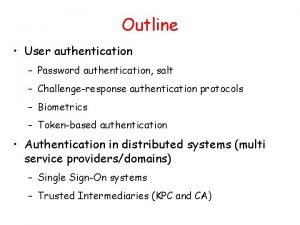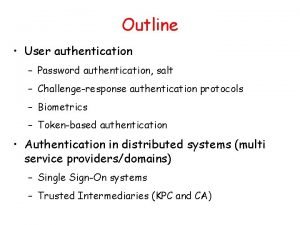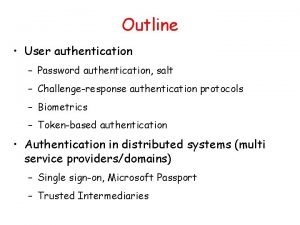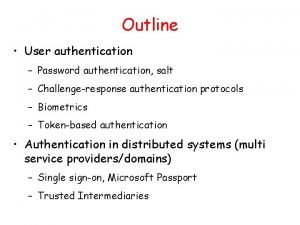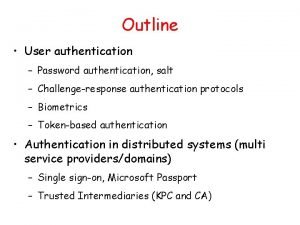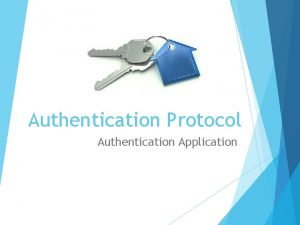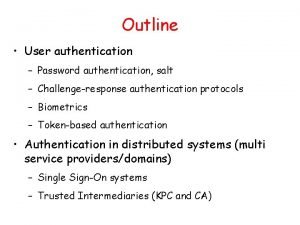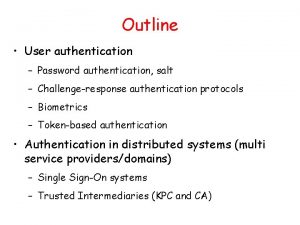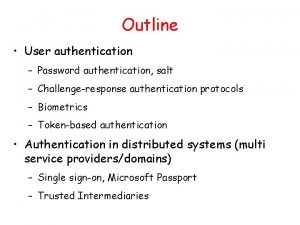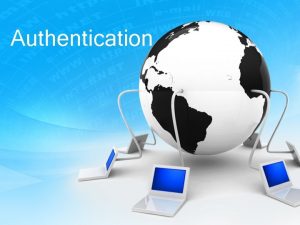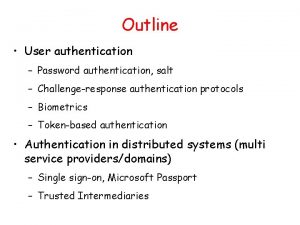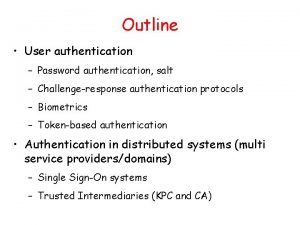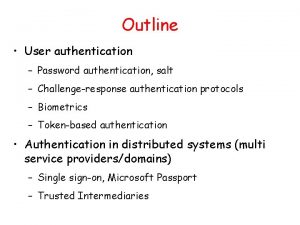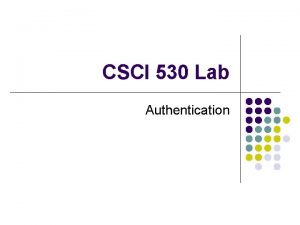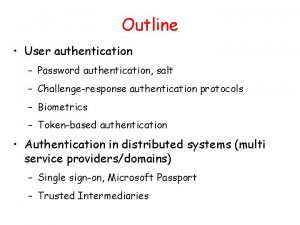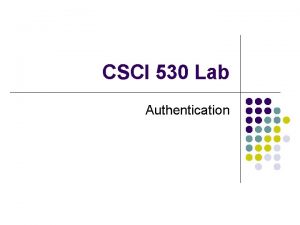CSCE 201 Identification and Authentication Fall 2015 Required





























- Slides: 29

CSCE 201 Identification and Authentication Fall 2015

Required reading list: – An Introduction to Computer Security: The NIST Handbook, http: //csrc. nist. gov/publications/nistpubs/800 -12/handbook. pdf : Chapter 16, IDENTIFICATION AND AUTHENTICATION, pages 180 -192 l Recommended: – Biometrics, from Wikipedia, the free encyclopedia, http: //en. wikipedia. org/wiki/Biometrics – John the Ripper password cracker http: //www. openwall. com/john/ – Brutus the remote password cracker http: //www. hoobie. net/brutus/ l CSCE 201 - Farkas 2

CSCE 201 - Farkas 3

Identification l Something you know l Something you own l Who you are l What you are l Where you are CSCE 201 - Farkas 4

Identification l Allows an entity (a user or a system) to prove its identity to another entity l Typically, the entity whose identity is verified reveals knowledge of some secret S to the verifier l Strong authentication: the entity reveals knowledge of S to the verifier without revealing S to the verifier CSCE 201 - Farkas 5

Identification Information Must be securely maintained by the system. CSCE 201 - Farkas 6

Authentication l Authentication mechanism: verifies the identification information l Access control mechanism: grant privileges upon successful authentication l Logging: record security relevant events in an audit trail CSCE 201 - Farkas 7

Authentication Requirements l Network must ensure – Data exchange is established with addressed peer entity not with an entity that masquerades or replays previous messages l Network must ensure data source is the one claimed CSCE 201 - Farkas 8

Passwords Commonly used method l For each user, system stores (user name, F(password)), where F is some transformation (e. g. , one-way hash) in a password file l – F(password) is easy to compute – From F(password), password is difficult to compute – Password is not stored in the system l When user enters the password, system computes F(password); match provides proof of identity CSCE 201 - Farkas 9

Vulnerabilities of Passwords l Inherent vulnerabilities – Easy to guess or snoop – No control on sharing l Practical vulnerabilities – Visible if unencrypted in distributed and network environment – Susceptible for replay attacks if encrypted naively l Password advantage – Easy to modify compromised password. CSCE 201 - Farkas 10

Attacks on Password l Guessing attack/dictionary attack l Social Engineering l Sniffing l Trojan login l Van Eck sniffing CSCE 201 - Farkas 11

Social Engineering l Attacker asks for password by masquerading as somebody else (not necessarily an authenticated user) l May be difficult to detect l Protection against social engineering: strict security policy and users’ education CSCE 201 - Farkas 12

Password Management Policy l Educate users to make better choices l Define rules for good password selection and ask users to follow them l Ask or force users to change their password periodically l Actively attempt to break user’s passwords and force users to change broken ones l Screen password choices CSCE 201 - Farkas 13

One-time Password Use the password exactly once! CSCE 201 - Farkas 14

Time Synchronized l There is a hand-held authenticator – It contains an internal clock, a secret key, and a display – Display outputs a function of the current time and the key – It changes about once per minute User supplies the user id and the display value l Host uses the secret key, the function and its clock to calculate the expected output l Login is valid if the values match l CSCE 201 - Farkas 15

Time Synchronized Secret key Encryption Time One Time Password CSCE 201 - Farkas 16

Challenge Response • Non-repeating challenges from the host is used • The device requires a keypad Work station Network Host User ID Challenge Response CSCE 201 - Farkas 17

Challenge Response Secret key Challenge Encryption One Time Password CSCE 201 - Farkas 18

Devices with Personal Identification Number (PIN) l Devices are subject to theft, some devices require PIN (something the user knows) l PIN is used by the device to authenticate the user l Problems with challenge/response schemes – Key database is extremely sensitive – This can be avoided if public key algorithms are used CSCE 201 - Farkas 19

Smart Cards l Portable devices with a CPU, I/O ports, and some nonvolatile memory l Can carry out computation required by public key algorithms and transmit directly to the host l Some use biometrics data about the user instead of the PIN CSCE 201 - Farkas 20

Biometrics l Fingerprint l Retina scan l Voice pattern l Signature l Typing style CSCE 201 - Farkas 21

Problems with Biometrics l Expensive – Retina scan (min. cost) about $ 2, 200 – Voice (min. cost) about $ 1, 500 – Signature (min. cost) about $ 1, 000 l False readings – Retina scan 1/10, 000+ – Signature 1/50 – Fingerprint 1/500 l Can’t be modified when compromised CSCE 201 - Farkas 22

Home Computer Security CSCE 201 - Farkas 23

Problem: You don’t remember your password Solutions: 1. Verify that you have typed the letters of your password in the correct case 2. Access a password hint on the Welcome screen 3. Use a password reset disk 4. Log on as administrator to assign a new password to your account CSCE 201 - Farkas 24

Password Case Sensitivity l Check CAPS LOCK key Question: Why do you want to use combination of symbols for your password? CSCE 201 - Farkas 25

Using the Password Reset Disk Create a password reset disk for your user account at the earliest opportunity l How to use the password reset disk l – Microsoft Windows remembers if you have created a password reset disk. Just click use your password reset disk – Follow the instructions of the Password Reset Wizard Question: Why should you safeguard your password reset disk? CSCE 201 - Farkas 26

Use a Password Hint Create a password hint: – Log on to your computer – Click Start, and then click Control Panel – Double-click User Accounts – Click your user account, and then click Change my password – Enter your current password, enter a new password, and then enter the new password again to confirm it – Enter the password hint, and then click Change Password – The change will take effect the next time that you log on l To display the hint, click the question mark (? ) that is next to your user account l CSCE 201 - Farkas 27

Create a Password Reset Disk l l l Click Start, and then click Control Panel Double-click User Accounts Click your user account, and then click Prevent a forgotten password. The Forgotten Password Wizard starts Follow the instructions NOTE: A password reset disk is valid until you create a new one; even if you change your password CSCE 201 - Farkas 28

Next Class Cyber stalking, Fraud and Abuse CSCE 201 - Farkas 29
 Peer entity authentication and data origin authentication
Peer entity authentication and data origin authentication Iff
Iff Positive identification example
Positive identification example Math portfolio project
Math portfolio project Authentication in cryptography and network security
Authentication in cryptography and network security Public key cryptography and message authentication
Public key cryptography and message authentication X.509 authentication service
X.509 authentication service Difference between law and ethic
Difference between law and ethic Kerberos x.509
Kerberos x.509 Authentication filters in mvc 5
Authentication filters in mvc 5 Authentication authorization auditing
Authentication authorization auditing Grid security infrastructure
Grid security infrastructure What is message authentication code
What is message authentication code Kerberos x.509
Kerberos x.509 Csce 221 tamu syllabus
Csce 221 tamu syllabus Csce 314
Csce 314 Csce 314
Csce 314 Csce 314 tamu
Csce 314 tamu Csce 314
Csce 314 Csce 314
Csce 314 Csce 314
Csce 314 Csce 481 tamu
Csce 481 tamu Csce 181
Csce 181 Csce 181
Csce 181 Csce 181
Csce 181 Csce 121 tamu
Csce 121 tamu Csce 411
Csce 411 Csce 355
Csce 355 Csce 355
Csce 355 Dropbox csce
Dropbox csce

